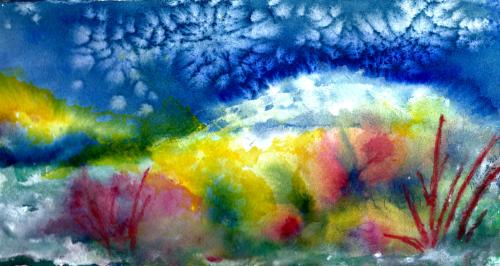
Here are some more items in my bag of tricks. Working down through the horizontals: a large comb for making streaky marks*. I also use a small, rat tail comb; a tooth brush for spattering wet paint; tongue compressors—I can’t recall where in the world I got those things but they are great for measuring and marking on those rare occasions when I use a pencil; a candle for creating areas of wax resist; a defunct credit card for scratching lines—making streaky grasses, etc; a knitting needle for making branches; and a jar lid mainly for making moons. I have several different size jar lids.
The verticals are craft Q tips of which I found hundreds—I think a lifetime supply—at a church rummage sale years ago, and a Mr. Clean Magic Eraser which rubs out areas of paint for various effects.
Not pictured are masking tape for masking out trees or buildings in order to preserve the white paper while painting a background, facial tissue for dabbing out clouds in a wet sky wash, and probably some other odds and ends which momentarily escape me.
I have always been a pack rat (albeit a very well organized one) and it’s so much fun to have an ongoing excuse for packing stuff in! Fortunately, I grew up with parents who let me have my own bit of Heaven in my childhood bedroom (probably because I was compulsively tidy); and for nearly 64 years I’ve been blessed with a husband who also enjoys being a pack rat. It could be disastrous if we disagreed on what is important in life! 🙂 MLB
*One of my favorite artists whose books and DVDs I treasure, British artist Shirley Trevena, introduced me to the comb streaking trick. Shirley’s still life watercolors are intriguing. Shirley says what she aims for is “an incredibly messy painting with lots of drips and blobs”, and she demonstrates how she “destroys” a painting—often with a comb streaked through wet paint, blurring the colors. Shirley’s “incredibly messy”, “destroyed” paintings are gorgeous—whereas when I try her tricks the results are often simply incredibly messy and destroyed. Good grief!!!
Anyway, for a treat you can GOOGLE “Shirley Trevena, artist”. You won’t be disappointed! 🙂





